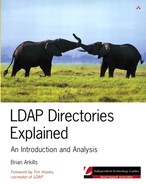Book Description
Directory technology promises to solve the problem of decentralized information that has arisen with the explosion of distributed computing. Lightweight Directory Access Protocol (LDAP) is a set of protocols that has become the Internet standard for accessing information directories. Until now, however, those curious about LDAP had no introductory source to learn how the technology can help them centrally manage information and reduce the cost of computing services.
LDAP Directories Explained provides technical managers and those new to directory services with a fundamental introduction to LDAP. This concise guide examines how the technology works and gives an overview of the most successful directory products in an easy-to-reference format.
Key topics include:
An overview of LDAP, including how directories differ from databases
The LDAP namespace, with an overview of DNS, LDAP object structure, and LDAP object naming
Client LDAP operations, including directory-enabled services and applications, searches, and the LDAP protocol
LDAP schema, including object classes, attributes, syntaxes, matching rules, and more
Directory management, including directory integration strategies, metadirectories, security, and more
LDAP vendors OpenLDAP, Microsoft Active Directory, and Directory Server
A case study of Stanford University's directory architecture, which illustrates how integral an LDAP directory can become to a business
If you are an information technology manager, LDAP Directories Explained will provide the technical foundation you need to make sound business decisions about LDAP. If you're a developer, this straightforward reference will bring you quickly up to speed on LDAP and directories.
020178792XB01292003
Table of Contents
- Copyright
- Independent Technology Guides
- Foreword
- Preface
- Acknowledgments
- I. How LDAP Works
- 1. Overview of LDAP
- 2. LDAP Namespace
- 3. Client LDAP Operations
- 4. LDAP Schema
- 5. Directory Management
- II. How Vendors Have Implemented LDAP
- Appendixes
- A. Client LDAP Operations Appendix
- B. Schema Appendix
- C. Stanford University Directory Architecture
- D. OpenLDAP Access Control
- E. Active Directory Controls Appendix
- F. Directory Server Appendix
- G. Online Reference Material
